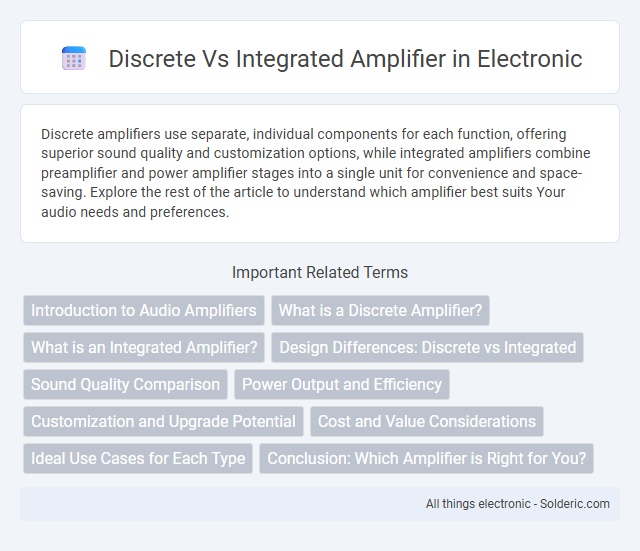Discrete amplifiers use separate, individual components for each function, offering superior sound quality and customization options, while integrated amplifiers combine preamplifier and power amplifier stages into a single unit for convenience and space-saving. Explore the rest of the article to understand which amplifier best suits Your audio needs and preferences.
Comparison Table
| Feature | Discrete Amplifier | Integrated Amplifier |
|---|---|---|
| Definition | Amplifier built using individual components like transistors and resistors. | Amplifier built as a single integrated circuit (IC) with all components embedded. |
| Performance | Higher customization and potentially superior sound quality. | Consistent performance with optimized design for general use. |
| Size | Generally larger due to separate components. | Compact and space-saving design. |
| Cost | Typically more expensive due to complex assembly. | Usually cost-effective and mass-produced. |
| Heat Dissipation | Better heat management via separate components. | Limited heat dissipation due to compact IC design. |
| Repair & Upgrade | Easier to repair and upgrade individual parts. | More difficult or impossible to repair or modify. |
| Applications | High-end audio systems, custom builds. | Consumer electronics, portable devices. |
Introduction to Audio Amplifiers
Discrete amplifiers use individual electronic components like transistors and resistors for tailored audio performance and easier customization. Integrated amplifiers combine preamplifier and power amplifier stages into a single unit, offering compactness and user-friendly operation. Your choice depends on whether you prioritize precise sound control or convenience and space-saving design in your audio setup.
What is a Discrete Amplifier?
A discrete amplifier is an electronic device built using individual components such as transistors, resistors, and capacitors, rather than integrated circuits. It offers greater customization and often superior audio fidelity due to precise component selection and circuit design. This type of amplifier is favored in high-end audio systems where tailored performance and detailed sound reproduction are critical.
What is an Integrated Amplifier?
An integrated amplifier combines a preamplifier and a power amplifier into a single unit, streamlining audio signal processing and amplification. This design reduces the need for separate components, saving space and simplifying the audio setup. Integrated amplifiers often feature built-in controls for volume, tone, and input selection, making them convenient for both beginners and audiophiles.
Design Differences: Discrete vs Integrated
Discrete amplifiers use separate, individual components like transistors and resistors for each stage, offering enhanced customization and repairability. Integrated amplifiers combine a preamplifier and power amplifier within a single chassis, providing convenience and space-saving benefits. Your choice depends on whether you prioritize high customization and potentially superior sound quality or streamlined operation and ease of use.
Sound Quality Comparison
Discrete amplifiers often deliver superior sound quality due to their dedicated components, which allow precise signal control and reduced distortion. Integrated amplifiers combine the preamplifier and power amplifier in one unit, providing convenience but sometimes sacrificing the nuanced audio detail found in discrete setups. Your choice influences tonal clarity and dynamic range, with discrete amplifiers typically offering richer, more detailed sound reproduction.
Power Output and Efficiency
Discrete amplifiers typically offer higher power output and greater thermal efficiency due to individualized transistor components optimized for performance. Integrated amplifiers, while more compact and cost-effective, often exhibit lower maximum power output and efficiency as a trade-off for combining multiple functions on a single chip. Power efficiency in discrete designs generally surpasses integrated counterparts, making them preferable for high-performance audio applications.
Customization and Upgrade Potential
Discrete amplifiers offer superior customization and upgrade potential due to their modular design, allowing you to swap out components such as transistors and capacitors for tailored performance improvements. Integrated amplifiers combine multiple functions into a single unit, limiting upgrade options and customization but ensuring compactness and convenience. Choosing a discrete amplifier empowers enthusiasts to fine-tune and enhance their audio system over time, while integrated models prioritize simplicity and space-saving.
Cost and Value Considerations
Discrete amplifiers generally have higher production costs due to individual component assembly and enhanced customization, often resulting in premium pricing. Integrated amplifiers combine preamp and power amp sections in one enclosure, offering cost-effective solutions with compact design and simplified wiring, making them accessible for budget-conscious buyers. Value considerations hinge on user priorities: discrete models emphasize audio fidelity and upgrade potential, while integrated units deliver convenience and affordability without sacrificing essential performance.
Ideal Use Cases for Each Type
Discrete amplifiers excel in high-fidelity audio setups requiring precise sound customization and component-level control, making them ideal for audiophiles and professional studio environments. Integrated amplifiers offer a compact, all-in-one solution combining preamp and power amp stages, best suited for casual listeners, home audio systems, and space-conscious setups. Choosing between discrete and integrated amplifiers depends on factors like desired sound quality, system complexity, and installation constraints.
Conclusion: Which Amplifier is Right for You?
Choosing between a discrete and integrated amplifier depends on your audio preferences, budget, and space constraints. Discrete amplifiers offer superior customization and often higher sound quality due to separate components but tend to be bulkier and more expensive. Integrated amplifiers provide convenience, compact design, and cost-effectiveness, making them ideal for most home audio setups seeking a balance of performance and simplicity.
discrete vs integrated amplifier Infographic

 solderic.com
solderic.com